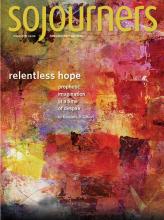AMONG THE MANY hopeful initiatives to come from the Vatican under Pope Francis is an attempt to rebuild the church’s relationship with the arts. Francis declared this to be among his priorities in his famous 2013 interview with Jesuit priest Antonio Spadaro (published in the U.S. by the journal America). Francis listed among his inspirations painters Caravaggio and Chagall, the Russian novelist Dostoevsky and the German poet Friedrich Hölderlin, the music of Bach and Mozart, and the films of Fellini and Rossellini.
Lately the pope’s passion for art has taken tangible form with an interview-based book in Italian, whose title translates to My Idea of Art, and a documentary film of the same name, subtitled in six languages, that tours the Vatican Museum’s artistic treasures. In the book, Pope Francis argues that great art can serve as an antidote to contemporary greed, exclusion, and waste and maintains that “a work of art is the strongest evidence that incarnation is possible.”
Pope Francis came to office determined to downgrade some of the papacy’s pomp and splendor. He lives in a guest house instead of the papal apartment. He wears sturdy black walking shoes instead of those iconic red slippers and a silver cross where his predecessors went for the gold. He seems like the sort who might auction off the Vatican’s art collection and give the money to the poor.
But Francis instead sees the church’s involvement with the arts, past and present, as an occasion for evangelization.
Read the Full Article

